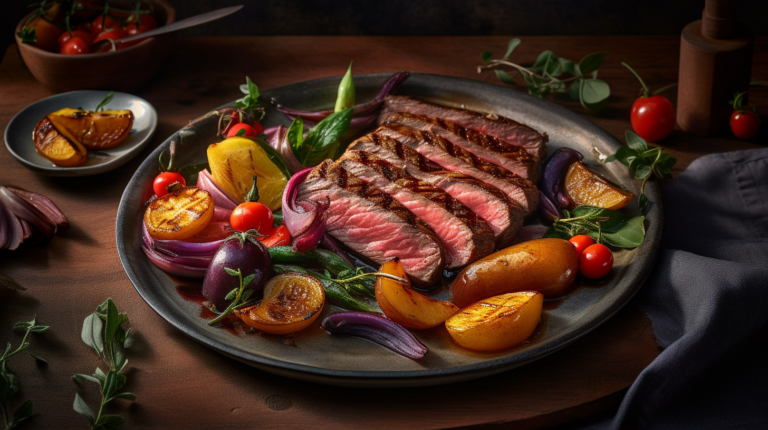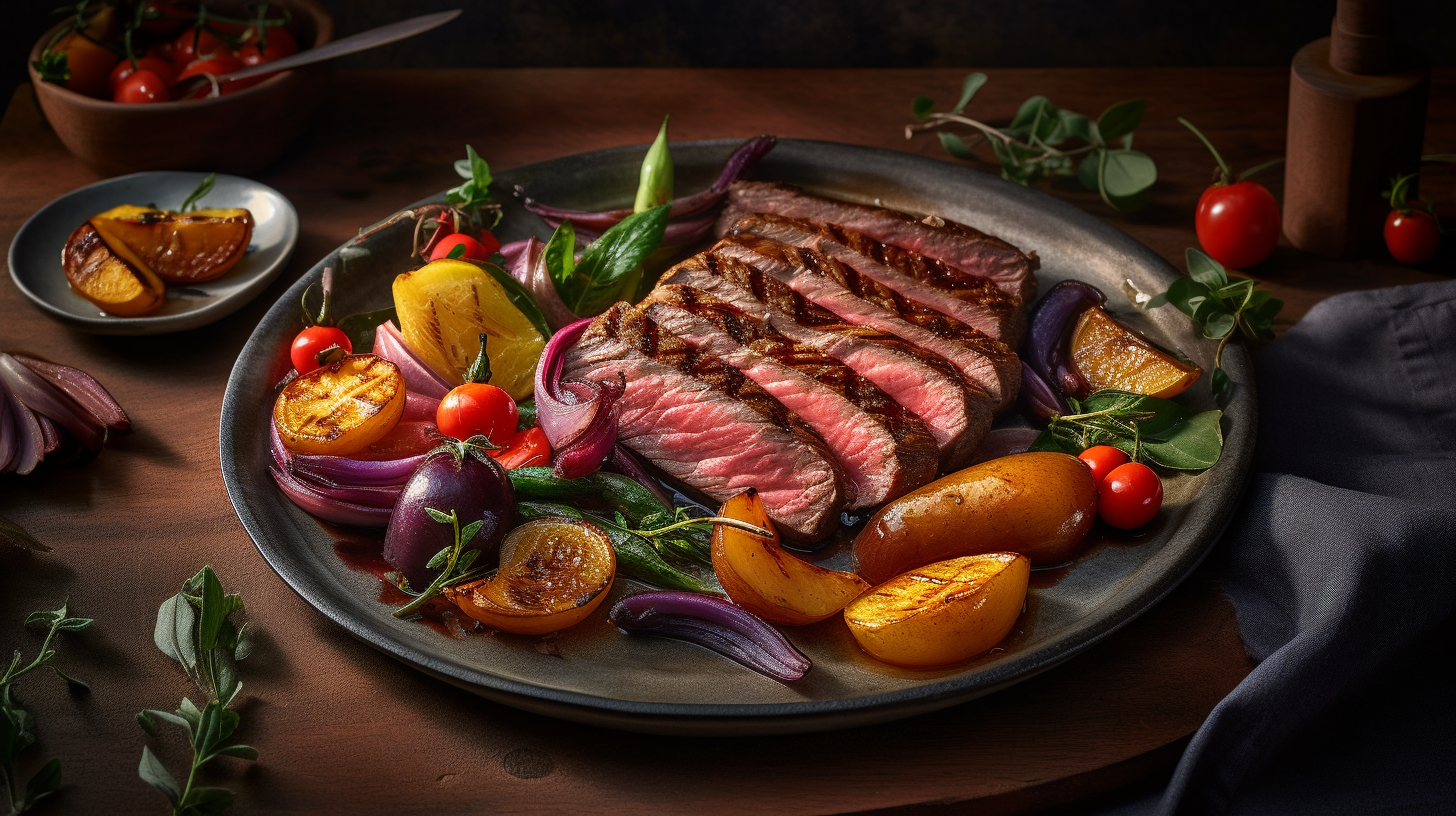Do you ever wonder why some people seem to effortlessly maintain a healthy weight while others struggle to shed those extra pounds? Well, here’s an interesting statistic for you: Did you know that the thermic effect of food can account for up to 10% of your daily energy expenditure?
That means that the simple act of eating can actually help you burn calories! In this article, we’ll dive deep into the fiery impact of food and explore how understanding the thermic effect can unlock the secrets to a faster metabolism.
So, what exactly is the thermic effect of food? It refers to the energy expenditure your body requires to digest, absorb, and metabolize the food you eat. In simpler terms, it’s the number of calories your body burns just by processing the food you consume.
This fascinating process can vary depending on the type of food you eat, with protein having the highest thermic effect, followed by carbohydrates and then fats. By understanding how different foods impact your metabolism, you can make more informed choices about what you eat and how it affects your weight.
What is the Thermic Effect of Food?
While you already know that food provides energy, have you ever considered the additional energy your body expends to digest, absorb, and process the nutrients from the food?
This additional energy expenditure is known as the thermic effect of food. It is the amount of calories burned during the process of food digestion and metabolism.
When you eat, your body has to work to break down the food into its basic components, such as carbohydrates, proteins, and fats. This process requires energy, which is measured in calories.
The thermic effect of food varies depending on the macronutrient composition of the meal. For example, protein has a higher thermic effect compared to carbohydrates and fats. This means that when you consume protein-rich foods, your body burns more calories during digestion and metabolism. Understanding the thermic effect of food is crucial because it can impact your overall energy balance and metabolism. By choosing foods with a higher thermic effect, you can potentially increase the amount of calories burned during digestion and support your weight loss or weight maintenance goals.
While proteins are notable for their higher thermic effect, it’s important not to overlook the role of dietary fats. Fats have the lowest thermic effect, at approximately 5-10%. Despite this, they are essential to a balanced diet. Fats contribute to healthy skin, hair, and nails, protect vital organs, and help maintain body temperature. Additionally, they provide a concentrated source of energy and help regulate the body’s insulin response to high-sugar foods.
Incorporating the right fats into your diet can enhance your health:
- Avocado: Rich in monounsaturated fats, ideal for heart health.
- Salmon: A great source of omega-3 fatty acids.
- Nuts and seeds: Packed with essential fatty acids and nutrients.
- Egg yolks: Provide healthy fats along with essential vitamins.
To make healthier cooking choices, consider swapping vegetable oils with olive or coconut oil for a beneficial fat alternative. By understanding and leveraging the thermic effect of different macronutrients, you can create a diet that not only supports your health but also aids in managing your energy balance effectively.
What Determines How Much Energy You Burn Each Day?
Your total energy burn—also called total energy expenditure—is made up of three key components:
Basal Metabolic Rate (BMR): This is your body’s baseline calorie burn, making up around 60–70% of your daily energy use. It powers essential functions like breathing, circulating blood, and keeping your body temperature steady—even when you’re just lounging on the couch.
Physical Activity: Roughly 15–30% of your daily burn comes from movement. That includes structured exercise and everything else, like walking to the fridge, typing at your desk, or fidgeting in your seat. All of that everyday motion is called nonexercise activity thermogenesis (NEAT), and it adds up fast.
Thermic Effect of Food (TEF): About 10% of your daily calories are burned just by eating. That’s right—digesting food takes effort, and your body uses energy to break it all down.
Your personal burn rate also depends on things like age, gender, weight, and how active you are. And remember: if you regularly eat more than you burn, your body stores the extra as fat. Knowing where your energy goes each day helps you strike the right balance—no guesswork needed.
How Does the Thermic Effect Affect Metabolism?
Imagine yourself sitting down to a delicious meal, and the way your body responds to the food you consume plays a significant role in how efficiently it burns calories. This is where the thermic effect of food comes into play. The thermic effect refers to the increase in energy expenditure that occurs after eating, as your body works to digest, absorb, and process the nutrients from your meal. This process actually requires energy, and the thermic effect can vary depending on the type of food you consume.
To understand how the thermic effect affects metabolism, let’s take a closer look at the different macronutrients and their corresponding thermic effect percentages:
| Macronutrient | Thermic Effect Percentage |
|---|---|
| Protein | 20-35% |
| Carbohydrates | 5-10% |
| Fat | 0-3% |
As you can see from the table, protein has the highest thermic effect, requiring your body to burn more calories to digest and process it. This means that by consuming protein-rich foods, you can actually increase your metabolism and burn more calories throughout the day. Carbohydrates, on the other hand, have a lower thermic effect, meaning that your body doesn’t have to work as hard to process them. Finally, fat has the lowest thermic effect, requiring the least energy for digestion.
Understanding the thermic effect of food and its impact on metabolism can help you make more informed choices about the types of foods you consume. By incorporating more protein into your diet, you can boost your metabolism and increase calorie burning. So, next time you sit down to a meal, consider the thermic effect and choose foods that help your body burn calories efficiently.
How Complex Carbohydrates Influence the Thermic Effect of Food and Energy Levels
Complex carbohydrates play a pivotal role in both the thermic effect of food (TEF) and your energy levels throughout the day. They are one of the more thermogenic macronutrients, contributing to a TEF ranging from 5-15%, influenced by the specific type of carbohydrate consumed.
Benefits of Complex Carbohydrates
- Steady Energy Release: Unlike their refined counterparts, complex carbs provide a gradual energy release. This is beneficial for maintaining sustained energy levels during activities such as personal training sessions and daily tasks.
- Higher Thermic Effect: Foods high in fiber, such as whole grains, digest more slowly. This slow digestion enhances the thermogenic response, as the body requires more energy to break them down.
- Nutritional Value: They are rich in materials like vitamins and minerals. Opting for wholegrain versions of rice, pasta, and bread over refined options ensures you’re receiving these vital nutrients.
Impact on Metabolism
Research from 2017 highlighted that substituting refined grains with whole grains can boost metabolism. Participants in the study experienced an increase in their metabolic rates, burning an additional 92 calories daily just by making this simple switch.
Practical Tip
For a lunch option that keeps energy stable, consider replacing a baked white potato, typically served with beans and cheese, with a sweet potato topped with tuna. This not only helps in avoiding the common afternoon energy slump but also supports metabolic efficiency.
By integrating complex carbohydrates into your diet, you experience not only a significant thermic boost but also enjoy longer-lasting energy levels without the typical post-meal crashes. This adjustment can lead to improved overall health and vitality.
How to Add More Fiber to Your Diet
Boosting your fiber intake is one of the easiest ways to support weight management, digestion, and steady energy—all without a major diet overhaul. Try these simple swaps and additions:
Choose whole grains
Skip the white bread and switch to fiber-packed alternatives like oats, brown rice, whole-wheat bread, or whole-grain pasta. These keep you full longer and support healthy digestion.
Pile on the fruits
Snack on fiber-rich fruits like apples, pears, bananas, avocados, kiwis, and plums. Mix in fresh and dried options for variety throughout your day.
Fill your plate with veggies
Aim to fill half your plate with vegetables at lunch and dinner. Great choices include broccoli, carrots, kale, zucchini, sweet potatoes, and green beans. Roast, steam, or toss them into soups and salads.
Lean on legumes
Chickpeas, lentils, and beans are fiber powerhouses. Add them to stews, grain bowls, or your favorite curry for an easy boost.
Snack with intent
For high-fiber snacks, go for air-popped popcorn, trail mix with dried fruit, or raw veggies with hummus.
A few smart changes go a long way—your gut, energy levels, and metabolism will thank you.
The Role of Fiber-Rich Foods in Weight Management
While fruits, vegetables, and whole grains don’t have the highest thermic effect compared to protein, their fiber content plays a powerful role in supporting weight management and overall health.
Here’s how fiber helps:
Promotes Fullness
High-fiber foods slow down digestion and increase satiety, helping you feel fuller for longer. This reduces the urge to overeat or snack excessively.
Supports Blood Sugar Stability
Fiber slows the absorption of sugar into the bloodstream, helping to avoid energy crashes and the cravings that follow.
Enhances Digestive Health
A diet rich in fiber keeps digestion running smoothly, which supports regularity and may indirectly aid in weight control.
Most people don’t get enough fiber. Aim for at least 15 grams per day, though higher intake—common in Mediterranean-style diets—can offer even more benefits.
Some easy high-fiber swaps include:
- Whole grains like oats, brown rice, and whole-grain bread
- Fruits like apples, pears, bananas, and kiwis
- Vegetables such as broccoli, sweet potatoes, carrots, and kale
By including more fiber-rich foods in your meals, you’re not just improving digestion—you’re also supporting metabolic health and long-term weight balance.
Understanding Your Body’s Metabolic Response to Dieting
When embarking on a weight loss journey, the body’s metabolism plays a crucial role. The key is understanding how metabolism responds to calorie deficits and the dietary choices we make.
Protein: The Metabolic Powerhouse
Our bodies handle excess calories differently based on their sources. Protein, for instance, has a high thermic effect. This means it requires more energy to digest, leading to fewer calories being stored as fat. Incorporating lean proteins such as chicken, fish, eggs, and legumes is not just beneficial for muscle repair but also keeps your metabolism active.
- Key Recommendation: Aim for approximately 1.8g of protein per kg of body weight.
The Risks of Extreme Dieting
Quick fixes like low-carb or low-fat diets might be tempting, but they’re not sustainable. Cutting out entire food groups can cause the body to shift into a conservative mode. Here’s why:
- Metabolic Slowdown: In response to a calorie deficit, your body may slow down its metabolic rate. This is a protective mechanism, ensuring you conserve energy.
- Calorie Retention: As metabolism slows, the body becomes adept at storing more of the calories you consume, often as fat.
Achieving a Balanced Calorie Deficit
For long-term results, it’s crucial to maintain a balanced approach. Rather than extreme restrictions, consider a moderate calorie deficit that allows for a variety of nutrients. Incorporate foods with high thermic effects to keep your metabolism active:
- Lean Meats & Fish: High in protein and low in fat.
- Legumes: Offer protein and fiber, essential for sustained energy release.
By focusing on a nutrient-rich diet and understanding your body’s metabolic needs, you can achieve sustainable weight loss while ensuring your metabolism remains efficient and healthy.
Factors Influencing the Thermic Effect
Explore the factors that can influence the thermic effect and discover how they can spark a metabolic fire within you.
Your body is a complex machine, and how it processes food plays a key role in your overall metabolism. The thermic effect of food refers to the energy required by your body to digest, absorb, and process the nutrients from the food you eat.
But did you know that certain factors can actually increase this thermic effect, leading to a higher metabolic rate?
One of the factors that can influence the thermic effect is the type of food you consume. Protein-rich foods, for example, have a much higher thermic effect than carbohydrates or fats. This means that when you eat protein, your body has to work harder to break it down and extract the nutrients, resulting in a higher calorie burn. So, if you want to kickstart your metabolism, consider incorporating more lean meats, poultry, fish, and legumes into your diet.
Another factor that can influence the thermic effect is the frequency and size of your meals. Eating smaller, more frequent meals throughout the day can actually increase your metabolic rate. This is because your body has to constantly digest and process the food, keeping your metabolism active. On the other hand, consuming large meals infrequently can cause your metabolism to slow down, as your body doesn’t have to work as hard to process the food. So, if you want to keep that metabolic fire burning, try spreading your meals out and opt for smaller, nutrient-dense options.
By understanding the various factors that can influence the thermic effect, you can ignite a metabolic fire within you. So, go ahead and choose protein-rich foods, eat smaller, more frequent meals, and watch as your metabolism starts to soar.
Key Factors That Impact the Thermic Effect
The thermic effect of food (TEF) isn’t one-size-fits-all. Several personal and dietary factors can influence how much energy your body uses to digest meals:
- Meal composition: Meals high in protein and fiber increase TEF more than those high in fat. Lean meats, legumes, and whole grains offer a greater thermogenic boost than processed or fatty foods.
- Age: As you age, your metabolic rate and TEF naturally decline, making protein intake and activity even more important to offset this reduction.
- Physical activity: Regular movement boosts your overall metabolic rate and can amplify the TEF of meals, particularly post-exercise.
- Body composition and metabolic health: Higher muscle mass supports a stronger thermic effect, while obesity or insulin resistance may reduce it.
- Meal frequency and size: Some research suggests that fewer, larger meals may produce a higher TEF than frequent snacking, but consistency and meal quality remain the most important factors.
Understanding these variables can help you fine-tune your diet and lifestyle to maximize calorie burn and metabolic efficiency.
Maximizing the Thermic Effect for Weight Loss
To maximize your weight loss, you need to focus on increasing the amount of energy your body burns when digesting and processing the food you eat. This is known as the thermic effect of food, and it can play a significant role in helping you shed those extra pounds.
The thermic effect refers to the energy expenditure required to digest, absorb, and process the nutrients in the food you consume. By choosing foods that have a higher thermic effect, you can effectively boost your metabolism and burn more calories throughout the day.
One way to maximize the thermic effect for weight loss is to incorporate protein-rich foods into your diet. Protein has the highest thermic effect of all the macronutrients, meaning that your body burns more calories when digesting and metabolizing protein than carbohydrates or fats. Approximately 25-30% of the calories you consume from protein are used for digestion and metabolism, giving protein a distinct metabolic advantage.
By including lean protein sources such as chicken, fish, tofu, and legumes in your meals, you can increase the thermic effect and promote weight loss. This metabolic boost is not just about burning more calories; it also plays a crucial role in enhancing satiety. A high-protein diet has been proven to keep you fuller for longer, which helps manage hunger and curb overeating.
Incorporating these protein-rich foods into your daily meals can help you effectively manage your weight while enjoying the benefits of increased metabolism and longer-lasting fullness.t
Additionally, adding spices and herbs to your meals can also help maximize the thermic effect. Certain spices, such as cayenne pepper, ginger, and cinnamon, have been shown to increase metabolism and enhance the thermic effect temporarily. These spices can also flavor your dishes, making them more enjoyable and satisfying.
When aiming for sustainable weight loss, it’s crucial to avoid eliminating whole food groups. Doing so can disrupt your body’s natural balance and lead to health complications over time.
Instead of drastic measures, such as cutting out carbs or fats entirely, focus on maintaining a diverse and balanced diet. Removing entire categories of foods often leads to a temporary calorie deficit. However, this approach triggers the body’s defense mechanisms, slowing metabolism and encouraging fat storage as a survival response.
Here’s why balance is key:
- Metabolic Health: Consuming a variety of foods helps maintain a steady metabolic rate. When you restrict, the body adapts by conserving energy, counteracting your weight loss efforts.
- Nutrient Intake: Each food group provides essential nutrients required for the body’s optimal functioning. Eliminating them can lead to deficiencies that affect overall health.
- Long-term Success: A sustainable plan involves a modest calorie deficit balanced across all food groups, ensuring your body receives complete nutrition. This approach fosters a healthy relationship with food and promotes lasting results.
In summary, moderation and balance in your dietary choices support long-term weight management without compromising your health or well-being.
Are High Thermic Foods Always Low in Calories?
Not always. Just because a food has a high thermic effect doesn’t mean it’s low in calories.
Take protein-rich foods, for example. Steak, salmon, and some cheeses have a high thermic effect—they require more energy to digest—but they can also be calorie-dense, especially if they’re high in fat. On the other hand, foods like cucumbers or watermelon are low in calories but don’t burn many calories during digestion.
That said, some foods offer the best of both worlds. Lean chicken breast, low-fat Greek yogurt, and cottage cheese deliver a strong thermic punch without piling on the calories.
So if your goal is to fuel your metabolism and manage your calorie intake, don’t assume all high thermic foods are light. Focus on lean, protein-packed options that work both ways.
The Benefits of Protein-Rich Foods for Long-Term Weight Regulation
Incorporating more protein-rich foods into your diet can significantly aid in long-term weight regulation. Here’s why:
1. Enhanced Calorie Burning: Protein has a higher thermic effect compared to other macronutrients. Simply put, your body burns more calories digesting protein than it does with fats or carbohydrates. This increased calorie expenditure can help prevent the storage of excess calories as fat.
2. Appetite Control: Protein plays a crucial role in keeping you full longer. It affects the levels of hormones that regulate hunger, helping to curb overeating and snacking between meals.
3. Muscle Preservation: Consuming adequate protein is vital for maintaining muscle mass, especially if you’re losing weight. Muscle burns more calories at rest than fat, so preserving it is essential for keeping your metabolism robust.
4. Nutrient Density: Protein-rich foods are often packed with other nutrients that are vital for good health. Foods like eggs, lean meats, legumes, and certain dairy products offer a host of vitamins and minerals alongside their protein content.
5. Balanced Diet: For optimal results, aim for at least 1.8 grams of protein per kg of body weight. Pair this with a variety of whole foods, including vegetables and whole grains, to ensure you’re getting a balanced intake of essential nutrients.
By focusing on protein as a cornerstone of your diet, you can help support your weight regulation efforts more effectively over the long term.
How Obesity and Insulin Resistance Affect the Thermic Effect
Your body’s ability to burn calories through digestion—known as the thermic effect of food—can be impacted by your metabolic health. Individuals living with obesity or insulin resistance may experience a reduced thermic effect, meaning fewer calories are burned after meals compared to those with leaner body compositions and better insulin sensitivity.
This makes weight management and metabolic efficiency more challenging. However, regular physical activity and a nutrient-dense diet can help improve insulin sensitivity, potentially boosting the thermic effect and supporting a healthier metabolism over time.
The Benefits of Choosing Wholegrain Options
When considering dietary choices, one may wonder why wholegrain options are often recommended over their refined counterparts. Here’s a breakdown of the advantages:
Nutritional Value
Wholegrain products, such as brown rice, whole-wheat pasta, and wholemeal bread, maintain the entire grain kernel, which includes the bran and germ. These components provide essential nutrients like fiber, vitamins, and minerals that are often stripped away during the refining process.
Satisfying Hunger
Wholegrains are known for their ability to keep you fuller for longer periods. The high fiber content aids in digestion and slows the release of sugar into the bloodstream. This can lead to steadier energy levels and a reduction in sudden hunger spikes.
Managing Blood Sugar Levels
Refined grains, which have had the bran and germ removed, can lead to rapid increases in blood sugar levels, followed by crashes that leave you feeling sluggish and hungry. In contrast, wholegrains help stabilize blood sugar, providing a more consistent energy supply.
Supporting Overall Health
Including wholegrain options in your diet is linked to various health benefits. Studies suggest they contribute to improved heart health and may lower the risk of certain chronic diseases. Additionally, the fiber in wholegrains supports a healthy digestive system.
In summary, opting for wholegrain choices over refined grains not only nourishes the body with vital nutrients but also promotes a feeling of sustained fullness and balanced energy throughout the day, all while supporting overall well-being.
Does Cooking Methods Affect the Thermic Effect of Food on Metabolism?
The debate over heating food in microwaves and its impact on the thermic effect of food on metabolism continues. While some believe that microwaving food can reduce its thermic effect, others argue that the difference is minimal. Further research is needed to determine the true impact of this cooking method.
The Role of Exercise in Enhancing the Thermic Effect
Get ready to kick your metabolism into high gear with exercise, because it’s like adding fuel to a fire! When it comes to enhancing the thermic effect of food, exercise plays a crucial role in revving up your metabolism and helping you burn more calories. Not only does exercise increase your heart rate and oxygen consumption, but it also stimulates the release of hormones that promote fat burning and muscle growth. So, whether you’re hitting the gym, going for a run, or even just taking a brisk walk, you’re giving your metabolism the boost it needs to work harder and more efficiently.
To better understand the impact of exercise on the thermic effect, let’s take a look at the table below:
| Exercise Type | Calories Burned per Hour | Intensity Level |
|---|---|---|
| Running | 600-900 | High |
| Cycling | 400-700 | Moderate |
| Walking | 200-400 | Low |
| Weightlifting | 300-500 | High |
| HIIT | 500-800 | High |
As you can see, the more intense the exercise, the more calories you burn. High-intensity exercises like running, weightlifting, and HIIT (high-intensity interval training) can significantly increase your metabolic rate and the thermic effect of food. However, even low-intensity exercises like walking can still have a positive impact on your metabolism. So, whether you prefer high-intensity workouts or enjoy a leisurely stroll, any exercise can help enhance the thermic effect and support your weight loss goals.
By incorporating regular exercise into your routine, you’re not only adding fuel to the fire of your metabolism but also taking a step towards serving your own health and well-being. So, lace up those sneakers, grab a buddy if you’d like, and get moving! Your body will thank you for it, as you’ll be on your way to maximizing the thermic effect and achieving your weight loss goals. Remember, every step counts, and every effort you make serves your ultimate desire for a healthier, happier you.
Frequently Asked Questions
Is the thermic effect of food the same for all types of foods?
The thermic effect of food varies depending on the type of food you consume. Some foods, like protein, have a higher thermic effect compared to others, such as carbohydrates or fats.
Can the thermic effect of food vary from person to person?
Yes, the thermic effect of food can vary from person to person. Just like how we all have different tastes, our bodies also have unique metabolic rates that can influence how much energy we burn from eating.
Does the thermic effect of food increase with the amount of food consumed?
Yes, the thermic effect of food does increase with the amount you consume. When you eat more, your body has to work harder to digest and metabolize the food, resulting in a higher thermic effect.
Are there any specific foods that have a higher thermic effect than others?
Yes, there are indeed specific foods that can ignite your metabolism like a blazing inferno! These fiery delights, such as chili peppers and protein-rich meats, can supercharge your body’s thermic effect and help you burn calories like never before.
Can cooking methods influence the thermic effect of food?
Yes, the thermic effect of food can be influenced by cooking methods. Cooking techniques like grilling and broiling can increase the thermic effect by promoting the breakdown of proteins, while frying can decrease it due to added fats.















